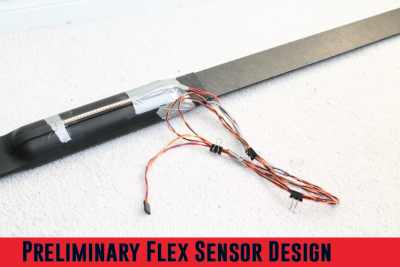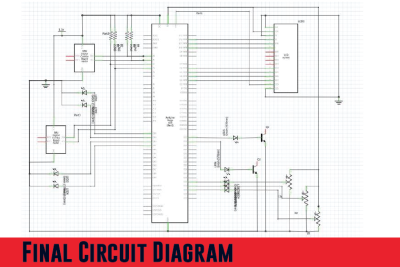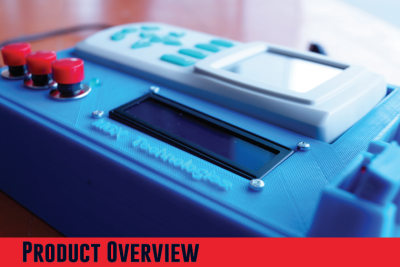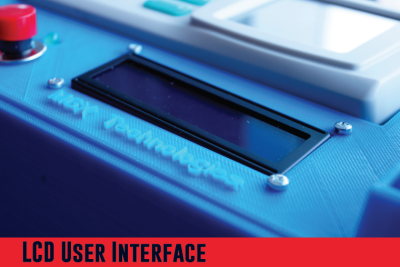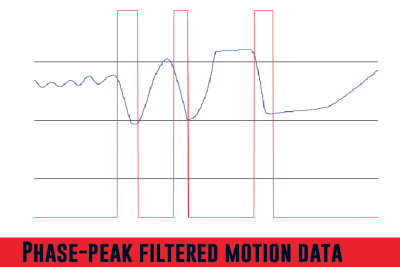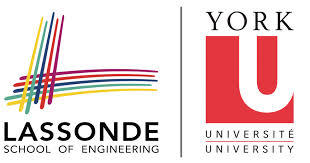Table of Contents
MGX Technologies
MGX Technologies - Preventing Muscle Atrophy in the Microgravity Environment
Students:
- Nicholas Bijnens
- Chitiiran Krishna Moorthy
- Kajendra Seevananthan
Project Adviser: Professor George Vukovich
Course Director: Professor Ebrahim Ghafar-Zadeh
https://www.youtube.com/watch
Short Bio
Nicholas Bijnens
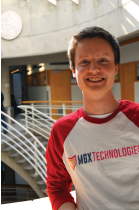 Nicholas Bijnens is a 4th year Space Engineering Student with interests in both scientific and artistic expression.
Nicholas Bijnens is a 4th year Space Engineering Student with interests in both scientific and artistic expression.
He has many years of experience working for the York University Student Centre as a graphic designer and photographer. This gave him the opportunity to not only design promotional material and develop marketing campaigns with a student target audience in mind but also gain invaluable experience taking stylized photographs for the Underground Restaurant.
He was also a part of the early stages of the Javelin space mission project, aiding in researching and designing different aspects of the overall mission. Furthermore, as part of the Payload Design course he took part in designing a drill to be used on a potential future NASA mission to Martian moons; Phobos and Deimos.
Chitiiran Krishna Moorthy
 Chitiiran Krishna Moorthy is a 4th year Space Engineering student and a self driven person constantly in pursuit of challenging design projects that allows application of theoretical knowledge.
Chitiiran Krishna Moorthy is a 4th year Space Engineering student and a self driven person constantly in pursuit of challenging design projects that allows application of theoretical knowledge.
He has experience in mechanical CAD modelling and has successfullied designed wind tunnel to study condensation of water on hydrophobic platform.The project is currenly under fabrication stage and aimed to aid European Space Agency's research on drop-wise condensation in collaboration with Mech. Eng. York University.
Chitiiran also has experience in design electrical circuit from his experience in making magic wand. This is a 3D printed wand that senses users' wrist motion and outputs visible laser beam. This project was chosen for student design challenge of Tangible, Embedded and Embodied Interaction, Munich, Germany 2014.
In 2012 he became certified member of MENSA Malaysia, the High IQ society. Naturally, he spends time solving puzzles and rubick's cubes. He also plays muggle quidditch from time to time.
Kajendra Seevananthan
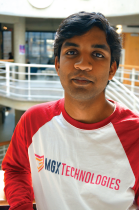 Kajendra Seevananthan is a 4th Year Space Engineering Student that is the lead programmer of the team.
Kajendra Seevananthan is a 4th Year Space Engineering Student that is the lead programmer of the team.
He has worked in Amro Zayed’s Laboratory (Department of Biology, York University) preforming bioinformatics analysis on a large data set of 100 bee genomes. He also worked for the Mechanical Engineering Department developing Image Processing software to measure contact angle in liquid bridge droplets.
He is currently working with Chitiiran and Sonal R. on a project to develop a magic wand that recognizes wrist kinesics using an Inertial Measurement Unit.
Description of Project
One of the main obstacles for long duration space flight is the debilitating effect of microgravity on astronauts; specifically muscle atrophy. We address this problem and mitigate this threat by challenging products on the market today and designing a device that optimizes the effects of a technique that has already been tested and trusted in the rehabilitation industry: Functional Electrical Stimulation (FES).
Research has shown that performing Neuromuscular Electrical Stimulation (NMES) along with exercise, otherwise known as FES, has the potential to significantly reduce muscle atrophy. However, FES devices currently on the market rely on the patient to sync their movement according to the stimulation provided by the NMES device. Our product, will allow appropriate stimulation according to the movement of the patient, providing an ideal environment to use FES for muscle atrophy prevention, and not solely for rehabilitation. It can be used with a variety of exercising equipment from dumbbells to tension machines through a convenient wristband. This wristband contains an Inertial Measurement Unit (IMU) that, through a microprocessor, allows the device to recognize the motion of the user, which will trigger stimulation to the targeted muscle only during isotonic contraction. This way, not only can the timing of the NMES application be optimized but also specifications of the routine.
This gives the product direct applications in the health and wellness market on Earth, as well as the potential to solve one of the most impactful problems in space travel to date; especially in light of space tourism.
Objectives
- Parse raw data from exercise motion
- Determine the appropriate stimulation technique
- Implement stimulation technique that adapts to individual exercise routines
- Demonstrate visual evidence of motion tracking and stimulation activation
Roles
Nicholas Bijnens
- Background research for existing technologies, possible solutions to preventing muscle atrophy in microgravity.
- Market research on proposed solutions and information on medical background behind NMES and FES technologies to be used.
- Contacted medical professionals Dr. Vincent Lo and Dr. Sunita Mathur and Faculty of Health Associate Dean Dr. Will Gage for assistance in determining the appropriate NMES settings, procedure and device.
- LCD User Interface Design
- Research and develop appropriate FES procedure and application.
- Branding, graphics, PR, poster design, video compilation, photography of product and team members
Chitiiran Krishna Moorthy
- Responsible for product and circuit development.
- Developed computer design of the final product using CREO-2 and had it 3D printed using Replicator 2. The product was designed such that it adapts to the newer design iteration without much alteration.
- Acceleration (ADXL345) and gyroscopic (ITG3200) sensor and user feedback interfaces (LCD Panel). I have developed the circuit for this hardware to communicate with our central processing unit Arduino Mega ADK.
- Translated circuit into physical proto-board that can be attached to Arduino Mega or Arduino Due. After the hardware components are in place, the required hardware level codes such as pin assignments, clock cycle, etc. was prepared.
Apart from engineering design process I was also actively searching for conference opportunity to get space industry’s attention to our research and we have been accepted in 2nd Annual SPACE Conference in Florida, Orlando to held 20th – 22nd June 2014.
Kajendra Seevananthan
- Analyze the signal of the IMU to detect correct stimulation phase
- Develop a safe trigger for NMES circuit to regulate the muscle stimulation
- Developing an text interface to integrate subcomponents
- Develop user interface so the user can select the appropriate exercise
- Managing the Finances and Budget of the Project
Discussion
Novelty of the project
While there are numerous products on the market for the specific purpose of performing FES for rehabilitation, these all rely on the user performing the movement when the stimulation is activated. This is because during rehabilitation the user normally has no or limited functionality of the targeted muscle and needs the stimulation to help them perform the exercise. However, to use these products on healthy individuals, such as astronauts, would cause unnecessary complexity in terms of timing issues but it also puts all the responsibility in terms of accuracy and effectiveness with the user, which is a major compromise. Our product makes it possible to time the stimulation according to the motion of the user.
Marketability of the project
Muscle atrophy in space is a tremendous obstacle. Chris Hadfield had to recover for over 6 months from his mission in space. Our design is aimed at long term space missions to the ISS, Mars and beyond. This product can also be used for rehabilitation of patients that are in long term bed rest and other physiotherapy.
Engineering design techniques
We used the Engineering Design methods we learned in ENG1000. We spent a significant amount of time reviewing existing applicable literature of this topic as research is a fundamental point. During the conceptualization phase we came up with many versions and used an iterative process design that was continuously upgraded as we made sufficient progress. We clarified the design requirements based on literature in what we needed to provide as a functional product. We emphasized from time to time the rudimentary design requirements so that these were always kept in mind throughout the entire project. We finalized a final design for which we then started manufacturing components and implementing necessary technologies. We finally made a prototype based on these subcomponents and assembled each of the components to launch prototype.
Design complexity
We kept our goal to choose a challenging topic while breaking down the problem into simpler components. As we learned in Engineering Design, the best solution to a problem is a simple one. We solved our key concepts using basic fundamental theory but with a unique application. We had to build a device that would interact with a user and provide stimulation based on the user’s movement. The stimulation needs to be in the correct phase of the exercise motion. We build major components separately to avoid failures and created redundancy checks.
Future development
Next steps for this project are to create a more compact CAD model. As part of this, the NMES signal could potentially be generated internally by the microprocessor. A crucial next step would then be to conduct clinical trials and eventually get the product approved by the FDA. Additionally, to avoid the use of heavy equipment being carried into space, such as the currently used ARED device on the International Space Station, the stimulation could concurrently be applied to the opposite muscle group to provide resistance. NASA, in collaboration with JAXA, is currently conducting a study on the ISS to confirm the effectiveness of this Hybrid Training technique (http://www.nasa.gov/mission_pages/station/research/experiments/163.html). The device could also be made compatible with inertial training devices such as the Bodyblade. This device in particular uses Isometric contractions, which have the potential to be even more effective than Isotonic contractions in preventing muscle atrophy.
Diagrams & Images
During early stages of the project, we used flex sensors, that are relatively cheaper, to obtain exercise motion data. However the sensors were not suitable for rigorous exercises as it broke off during testing phase. The flex sensor also does not support multi-dimensional data. Thus, we decided to move on to a more expensive and reliable IMU sensor which is both durable and supports multi-dimensional data.
The preliminary circuit shown here supports the Inertial Measurement Unit (IMU) and user interface integrated with processing unit: Arduino Uno.
The Computer Aided Design (CAD) model was developed based on the real dimensions of the electronic components that we expected to use. The design discussion included many aspects, notably user safety, ergonomics, failure point, etc.
The CAD design shown in the previous figure was 3D printed with the aid of Graphics and Media at York, GaMaY. The first printed version was noticed to have low dimension tolerance and did not pass our quality assurance requirements. The actual components did not fit perfectly in the printed case. This was fixed in the second iteration and all the components had a pre-determined home. Later on, a few modification were made inside the case to adapt to the switch to more powerful processing unit: Arduino Mega ADK.
The final circuit shown here includes all the components that are part of the final product. This stage of the project gave us great opportunity to apply our knowledge from courses.
Our design makes use of a 6 degree-of-freedom IMU connected to an Arduino microcontroller to detect the user's motion throughout the exercise and trigger the NMES whenever a concentric isotonic contraction occurs. The IMU is built into a wristband for user comfort and can therefore be used with any existing exercise equipment, both in space and on Earth. Once the correct contracting motion is detected, the Arduino sends a voltage of 5V to the base of a transistor in the NMES control circuit which turns on the electrical stimulation. Once again, when the contracting motion has finished, the Arduino removes the base voltage and the stimulation is stopped.
The NMES settings are preliminarily set to an 85 Hz bi-phasic square wave, with a 400 microsecond pulse width. The amplitude of the signal needs to be set manually for each user as this setting needs to be maximized while still remaining comfortable. The higher them amplitude, the more intense the stimulated contraction.
The LCD user interface not only provides the user with a way to interact with the product but also helps to optimize the workout and make the stimulation as effective as possible. Ideally it should operate under a 1/2 duty cycle, meaning 1 second of stimulation for every 2 seconds of active rest. Therefore, the user interface will display warnings when the current workout is deviating from this optimal tempo.
Achieved Results
Satisfied objectives:
- Parsed raw data from exercise motion
- Determined the appropriate stimulation technique
- Implemented stimulation technique that adapts to individual exercise routines
- Demonstrated visual evidence of motion tracking and stimulation activation
All objectives were met with a high degree of quality as shown below.
Limb motion is a natural part of exercise. By tracking the motion's acceleration and gyroscopic values, the perfect time to stimulate the muscle can be identified. The figure above shows the initial raw data that is obtained from the sensor.
After filtering the raw values via custom made phase-peak filter, the data is now useful. The sensor data for a session involving bicep curl is shown next where the stimulation is applied during concentric contraction of the muscle. This phase of exercise is the part under the red line in the graph shown at the top. The beauty of the device is that the stimulation is only initiated when the muscle is in the right state of concentric contraction.
In the graph provided, the exercise motion is filtered and any inadvertent movements do not trigger the muscle stimulation. Only precise concentric muscle contraction motion can trigger the muscle stimulation while any inadequate motion is filtered to comply with medical professional and existing literature.
Highlights
- Team accepted into The 2nd Space Conference 2014 (Scientific Preparatory Academy for Cosmic Explorers) http://spaceconf.com/2014/
- Received consultation and advice from health professionals Drs. Vincent Lo, Sunita Mathur and William Gage http://www.uhn.ca/
Conclusion
The purpose of this project is to design a piece of equipment that will significantly reduce or eliminate muscle atrophy due to the microgravity environment and is succesfully met. This project aims at astronauts for manned missions to Mars, whether it is for scientific or other purposes, and other future manned missions to planetary bodies with a microgravity environment but could also be extended to the rehabilitation industry here on Earth.


